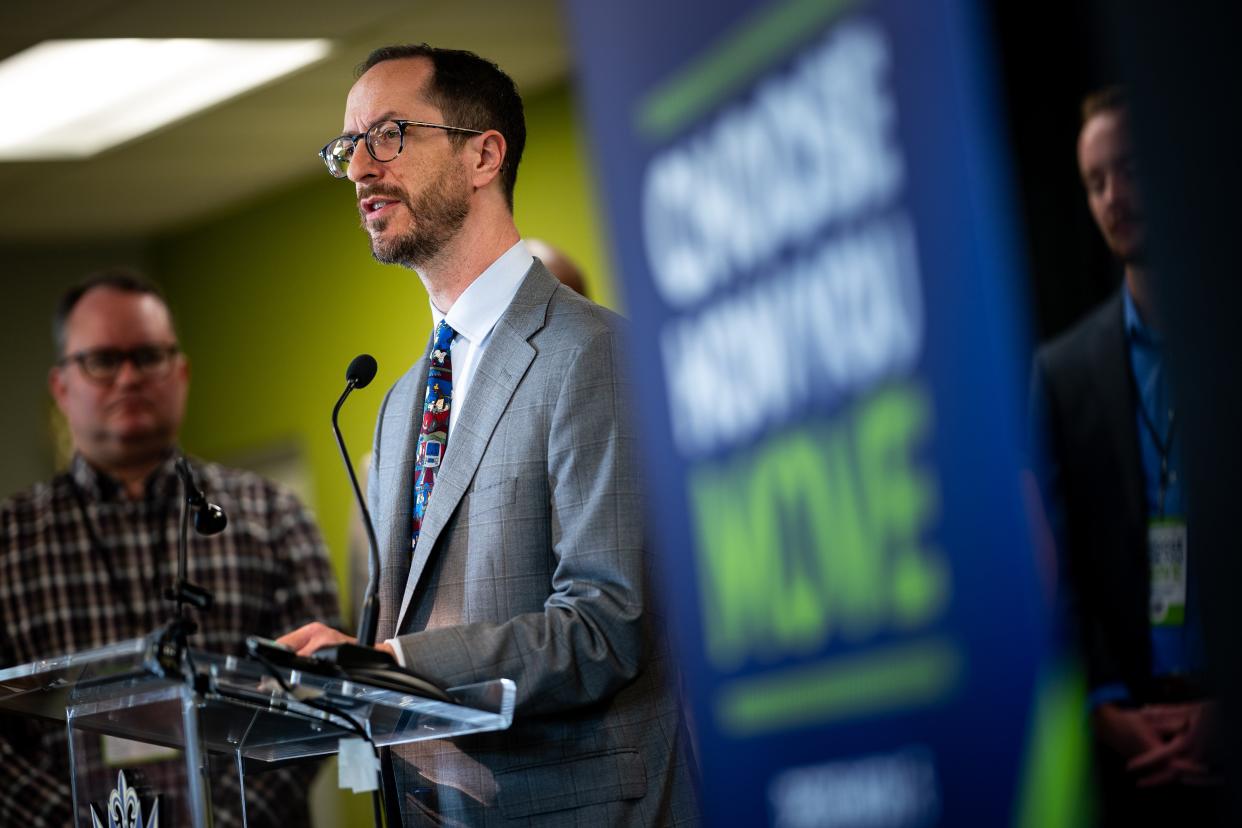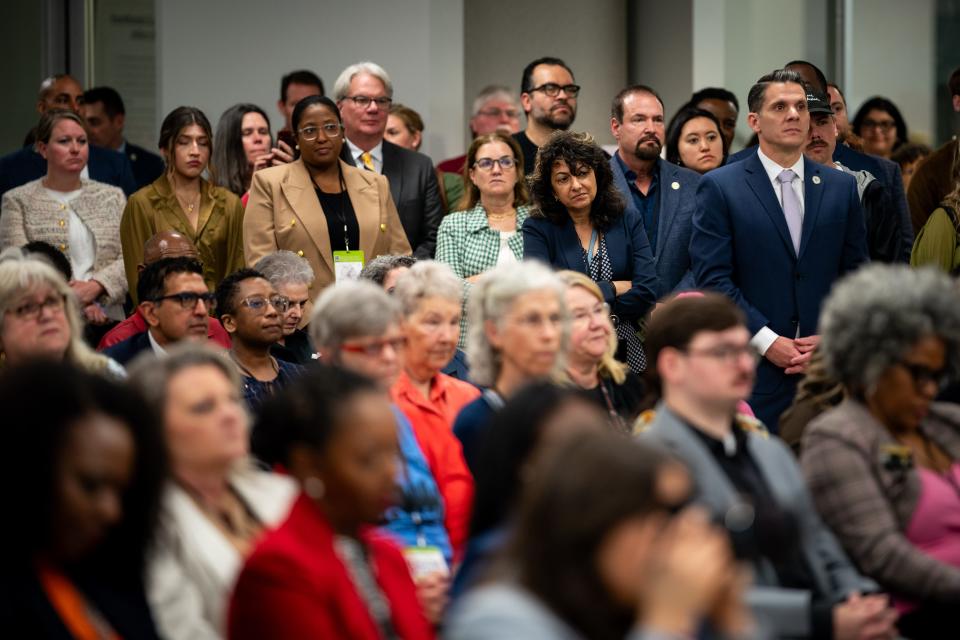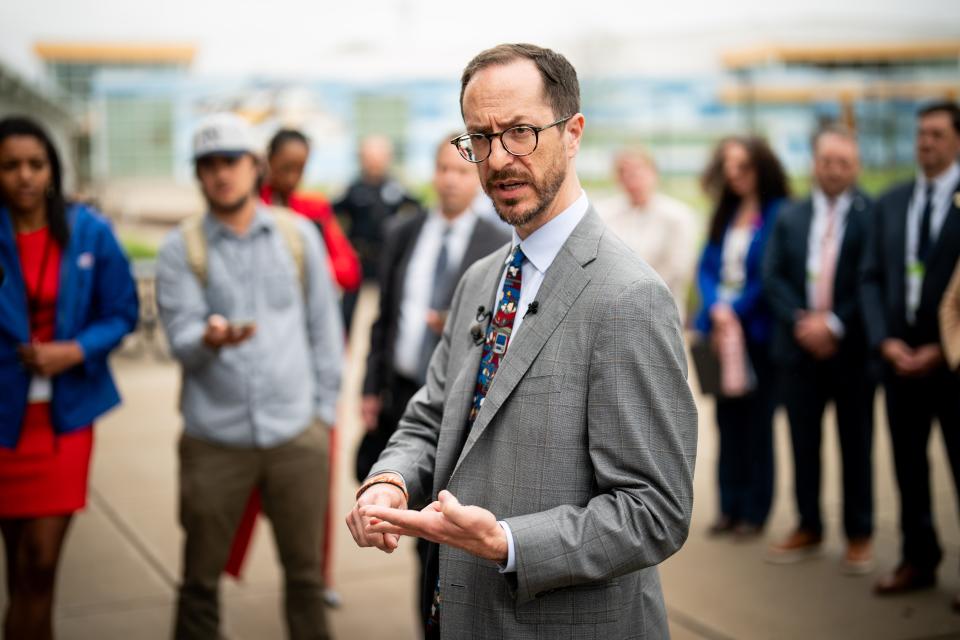Nashville's $3.1B transit plan: What's in it and how much it will cost taxpayers

Mayor Freddie O'Connell on Friday unveiled the estimated $3.1 billion final transit plan and accompanying sales tax increase that will appear on Nashville voters' ballots this November.
If voters approve, a half-cent sales tax increase would fund accelerated expansion of Nashville's bus system, build out dozens of miles of sidewalks and bike lanes and upgrade nearly 600 traffic signals to better handle vehicle congestion.
O'Connell addressed a packed room at the Southeast Community Center in Antioch, which is slated to become a neighborhood transit center, wearing a Peanuts transit-themed tie. The program, he said, draws from 70 previous studies and plans for improving Nashville's transit, as well as more that 66,000 points of input collected from the public over the last several years.
"It's not a new conversation, but it is a new opportunity," O'Connell said. "It is an opportunity to move after being stuck for so long, and it's an opportunity to invest in ourselves and the people who make our city go, and … invest in options for how to move around the city conveniently and safely."
The cost of the total "Choose How You Move" package, including funds set aside for anti-displacement and equity initiatives, is currently estimated around $3.1 billion in 2024 dollars, according to plan documents.
Recurring costs may total an estimated $111 million. The plan's financial elements are undergoing a third-party audit and review by the state comptroller, and more financial details are expected to be released upon the review's completion.
The tax increase will cover around 40% of the plan's total cost, with the remainder expected to be funded through fares, bonds and state and federal programs. Having a dedicated source of transit funding will make Nashville more competitive for limited federal grant funds, O'Connell said.
An average family will pay about $70 per year or less through the higher sales tax to fund it, O'Connell said Friday, adding that people who live closest to transit today save around $200 per year than households located farther away.
The announcement comes seven months into O'Connell's first year as mayor, and solidifies the path forward for what could ultimately be one of his most consequential decisions as Nashville's top elected official.

He announced his intention to push forward with a transit referendum in February, aiming for a Nov. 5 vote that coincides with the typically higher turnout of a presidential election. O'Connell's administration has been working on a tight timeline to clear the state and local hurdles necessary to get the plan on the ballot.
The comptroller's review of the program's financial details is expected to be complete by May 31.
The administration will solicit public feedback and seek approval from Metro Council — all before the final ballot text is due to the Davidson County Election Commission on Aug. 22. In the meantime, O'Connell and other supporters of the plan will campaign for public support. The "Nashville Moves" campaign to support the transit improvement program will launch Friday evening.
"It's your move, Nashville," he said. "Let's go."
What's in the Nashville transit plan?

Nearly 60% of the transit improvement program focuses on the expansion and enhancement of WeGo bus services. Light rail, which is about five times more expensive to install than a comprehensive bus service, is not part of the plan.
"Choose How You Move" would nearly double WeGo service from current levels, updating dozens of routes, creating four new express routes and boosting frequency.
Bus system essentials would see significant upgrades, including:
285 upgraded bus stops
12 new transit centers to support better connections outside of downtown and offer amenities
17 park-and-ride locations
Two bus garages
65 new buses
What could Nashville transit look like? New North Nashville center offers glimpse
The program also includes plans to purchase about 26 acres of land adjacent to transit center locations to ultimately be used for things like housing, parks and other public benefits.
Fifty-four miles of high-capacity transit corridors would upgrade roadways for vehicles, buses, cyclists and pedestrians on the city's heaviest traffic routes. Priority bus lanes would be installed in strategic areas to prevent WeGo buses from getting stuck in traffic.
Improvements to sidewalks, signals, streets and safety include:
86 miles of sidewalks (when paired with annual capital spending on sidewalks, this would effectively fund all of the city's 2022 WalknBike plan priority sidewalk network)
592 replaced or upgraded smart signals that can adapt based on demand and work with a forthcoming traffic management center to reduce time that drivers spend at red lights
39 miles of complete streets, including bikeway construction and safety improvements to Nashville's most dangerous roadways
Choose How You Move Transit Improvement Program Maps by USA TODAY Network on Scribd
What a sales tax bump means for your wallet
Davidson County residents currently pay 6.25% sales tax on most groceries (except prepared foods, alcohol and tobacco, candy and dietary supplements) and 9.25% on everything else.
Raising the local sales tax 0.5% would bump that up to 6.75% for groceries and 9.75% for other taxable goods, bringing Nashville's sales tax to the same level as several surrounding counties.
For a single adult, that could mean paying an extra $4 per month in tax on groceries and other household goods, based on average household costs in Davidson County, according to MIT's Living Wage Calculator. A family with two adults and two children could pay around $10 more per month in sales tax on those basics.
The plan's proposed timeline
Should the sales tax increase pass in November, the increase could go into effect on Feb. 1, 2025.
Immediate improvements would include:
WeGo bus service enhancements
Lighting and safety improvements
Early improvements to sidewalks, safety measures and traffic signals
A microtransit pilot program through WeGo Link, which partners with rideshare providers to offer subsidized fare to certain bus stops for riders in less-dense areas of the county
Within two years:
"Substantial" bus service improvements to hours and frequency
Sidewalk and upgraded signal installation continues
The first "Complete Street" project (which will include updates for pedestrians, cyclists, drivers and transit users) will be completed
Within five years:
More than 150 signals will be upgraded along with the Traffic Management Center
All-Access Corridors begin high-frequency bus service on West End, Charlotte Pike and between Elizabeth Duff Transit Center and South Broadway (through James Robertson Parkway, Rosa L. Parks Blvd. and Lafayette Street)
Within 10 years:
60 miles of sidewalks will be built
All-Access Corridors will begin high-frequency bus service on Murfreesboro Pike, Gallatin Pike and Clarksville Pike
Downtown, All-Access Corridors will provide high-frequency service on James Robertson Parkway linking the Elizabeth Duff Transit Center to the East Bank, and the East Bank to South Broadway via the Gateway Bridge
Within 15 years:
Nearly 600 traffic signals will be upgraded
78 miles of the Vision Zero high-injury network will have safety improvements
86 miles of new sidewalk will be complete
High capacity transit will be available on Dickerson Pike and Nolensville Pike, rounding out service on Nashville's 10 busiest roadways.
What's next for Nashville transit
May 31: Financial certification from State Comptroller
June 7: Transit Improvement Plan/Ordinance filed for Metro Council review
Aug. 6: Metro Council final reading and vote
Aug. 22: Transit Improvement Plan ballot language must be submitted to the Davidson County Election Commission
Oct. 16: Early voting begins
Nov. 5: Election Day
This article originally appeared on Nashville Tennessean: Nashville's $3.1B transit plan: What's in it? how much will it cost?
